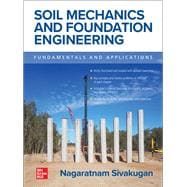Preface
Symbols
1 Geotechnical Engineering
1.1 Introduction
1.2 Soils and Other Engineering Materials
1.3 Geotechnical Applications
1.4 Standards, Measurements, and Significant Digits
1.5 Physical and Numerical Modeling
1.6 Geotechnical Engineering Literature
1.7 Workplace Health and Safety and Risk Assessment
1.8 Factor of Safety
1.9 Professional Registration and Continuing Professional Development
References
Part 1 Fundamentals
2 Phase Relations
2.1 Introduction
2.2 Phase Diagram and Definitions
2.3 Phase Diagram for Vs = 1
2.4 Laboratory Measurements
2.5 Main Points
Review Exercises
References
3 Soil Classification
3.1 Introduction
3.2 Origin of Soils
3.3 Grain Size Distribution
3.4 Atterberg Limits
3.5 Unified Soil Classification System
3.6 AASHTO Soil Classification System
3.7 Visual Classification and Description
3.8 Clay Mineralogy
3.9 Main Points
Review Exercises
References
4 Compaction
4.1 Introduction
4.2 Ground Improvement Techniques
4.3 Compaction Curve
4.4 Laboratory Compaction
4.5 Zero Air Void Curve
4.6 Field Compaction
4.7 Compaction Specifications and Control
4.8 California Bearing Ratio
4.9 Other Ground Improvement Techniques
4.10 Main Points
Review Exercises
References
5 Effective Stresses
5.1 Introduction
5.2 Vertical Overburden Stresses
5.3 Terzaghi’s Effective Stress Principle
5.4 Capillary Effects in Soils
5.5 Main Points
Review Exercises
References
6 Permeability and Seepage
6.1 Introduction
6.2 Bernoulli’s Equation
6.3 Darcy’s Law
6.4 Laboratory Determination of Hydraulic Conductivity
6.5 Field Determination of Hydraulic Conductivity
6.6 Stresses in Soils due to Flow
6.7 Equivalent Hydraulic Conductivity of Stratified Soils
6.8 Flow Nets
6.9 Design of Granular Filters
6.10 Seepage through an Embankment on an Impervious Base
6.11 Method of Fragments
6.12 Main Points
Review Exercises
References
7 Vertical Stresses under Loaded Areas
7.1 Introduction
7.2 Vertical Stress Increase due to a Point Load
7.3 Vertical Stress Increase due to a Line Load
7.4 Vertical Stress Increase due to a Strip Load
7.5 Vertical Stress Increase under the Corner of a Rectangular Load
7.6 2:1 Distribution for a Uniform Rectangular Load
7.7 Pressure Isobars under Square and Strip Flexible Uniform Loads
7.8 Vertical Stress Increase under an Embankment Load
7.9 Vertical Stress Increase beneath the Center of a Uniform Circular Load
7.10 Newmark’s Chart
7.11 Main Points
Review Exercises
References
8 Consolidation
8.1 Introduction
8.2 Fundamentals
8.3 One-Dimensional Consolidation
8.4 One-Dimensional Consolidation Test
8.5 Field Corrections to e vs. log s'v Plot Developed in the Laboratory
8.6 Determination of Final Consolidation Settlement
8.7 Preloading
8.8 Time Rate of Consolidation
8.9 Secondary Compression
8.10 A Note on Preloading
8.11 Main Points
Review Exercises
References
9 Shear Strength
9.1 Introduction
9.2 Mohr’s Circles—A Review
9.3 Mohr-Coulomb Failure Criterion
9.4 A Simple Loading Scenario and Relevance of Mohr’s Circle
9.5 Mohr’s Circles and Failure Envelopes in Terms of Total and Effective Stresses
9.6 Drained and Undrained Loadings
9.7 Triaxial Test
9.8 Direct Shear Test
9.9 Peak, Residual, and Critical States
9.10 Skempton’s Pore Pressure Coefficients for Undrained Loading
9.11 Relationship between s1 and s3 at Failure
9.12 Stress Paths
9.13 Critical State Soil Mechanics
9.14 Main Points
Review Exercises
References
10 Lateral Earth Pressures
10.1 Introduction
10.2 At-Rest State and K0
10.3 Active and Passive States
10.4 Rankine’s Earth Pressure Theory
10.5 Coulomb’s Earth Pressure Theory
10.6 Lateral Earth Pressures Based on Elastic Analysis
10.7 Main Points
Review Exercises
References
Part 2 Applications
11 Site Investigation
11.1 Introduction
11.2 Spacing and Depth of Investigation
11.3 Boring and Sampling
11.4 Laboratory versus In Situ Tests
11.5 In Situ Testing
11.6 Standard Penetration Test
11.7 Cone Penetration Test
11.8 Vane Shear Test
11.9 Other In Situ Tests
11.10 Bore Logs
11.11 Geotechnical Instrumentation
11.12 Geophysical Methods
11.13 Main Points
Review Exercises
References
12 Shallow Foundations
12.1 Introduction
12.2 General, Local, and Punching Shear Failure Modes
12.3 Terzaghi’s Bearing Capacity Theory
12.4 Gross and Net Pressures
12.5 The General Bearing Capacity Equation
12.6 Pressure Distributions beneath Eccentrically Loaded Foundations
12.7 Raft Foundations
12.8 Total and Differential Settlements
12.9 Settlement Computation Based on Elastic Analysis (Drained Soils)
12.10 Settlement Computations in Granular Soils
12.11 Settlement Computations in Cohesive Soils
12.12 Main Points
Review Exercises
References
13 Deep Foundations
13.1 Introduction
13.2 Pile Materials
13.3 Pile Installation
13.4 Shaft and Tip Loads
13.5 Pile Load Transfer Mechanism
13.6 Load-Carrying Capacity of a Single Pile
13.7 Pile Driving
13.8 Pile Load Test
13.9 Settlement of a Pile
13.10 Pile Groups
13.11 Foundations for Super-Tall Buildings
13.12 Rock-Socketed Piles
13.13 Main Points
Review Exercises
References
14 Earth Retaining Structures
14.1 Introduction
14.2 Retaining Walls
14.3 Cantilever Sheet Pile Walls
14.4 Anchored Sheet Piles
14.5 Braced Excavations
14.6 Retaining Walls Made of Piles
14.7 Main Points
Review Exercises
References
15 Slope Stability
15.1 Introduction
15.2 Factor of Safety
15.3 Stability of Homogeneous Undrained Clay Slopes
15.4 Taylor’s Stability Chart for Undrained Clays
15.5 Taylor’s Stability Chart for c' - f' Soils
15.6 Cousins’ Stability Chart
15.7 Michalowski’s (2002) Stability Charts for Slopes Subjected to Pore Water Pressures
15.8 Method of Slices
15.9 Infinite Slopes
15.10 Main Points
Review Exercises
References
16 Reliability-Based Design
16.1 Introduction
16.2 Capacity-Demand Model
16.3 Allowable Stress Design
16.4 Load and Resistance Factor Design
16.5 A Probabilistic Approach
16.6 Determination of the Mean and Standard Deviation of Capacity and Demand
16.7 Main Points
Review Exercises
References
A Unsaturated Soil Mechanics
B Vesic’s (1973) Factors for Eq. (12.11)
C Units and Conversions
Index








